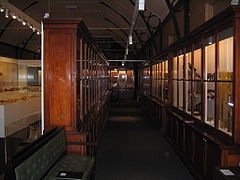
Macleay Museum
Encyclopedia

Sydney
Sydney is the most populous city in Australia and the state capital of New South Wales. Sydney is located on Australia's south-east coast of the Tasman Sea. As of June 2010, the greater metropolitan area had an approximate population of 4.6 million people...
, Australia
Australia
Australia , officially the Commonwealth of Australia, is a country in the Southern Hemisphere comprising the mainland of the Australian continent, the island of Tasmania, and numerous smaller islands in the Indian and Pacific Oceans. It is the world's sixth-largest country by total area...
, is a natural history museum located on the main campus of the University of Sydney
University of Sydney
The University of Sydney is a public university located in Sydney, New South Wales. The main campus spreads across the suburbs of Camperdown and Darlington on the southwestern outskirts of the Sydney CBD. Founded in 1850, it is the oldest university in Australia and Oceania...
.
History
The building in which the museum is housed was built off Science Lane (within the University of SydneyUniversity of Sydney
The University of Sydney is a public university located in Sydney, New South Wales. The main campus spreads across the suburbs of Camperdown and Darlington on the southwestern outskirts of the Sydney CBD. Founded in 1850, it is the oldest university in Australia and Oceania...
) in 1887. The collections of the Macleay Museum are based largely on the efforts and acquisitions of the Macleays, one of the pre-eminent families in colonial Sydney: Alexander Macleay
Alexander Macleay
Hon. Alexander Macleay MLC FLS FRS was a leading member of the Linnean Society and a fellow of the Royal Society.Macleay was born on Ross-shire, Scotland, eldest son of William Macleay, provost of Wick...
, William Sharp Macleay
William Sharp MacLeay
William Sharp Macleay was a British civil servant and entomologist.-Early life:Macleay was born in London, eldest son of Alexander Macleay who named him for his then business partner, fellow wine merchant William Sharp. He attended Westminster School and Trinity College, Cambridge graduating with...
and William John Macleay
William John Macleay
Sir William John Macleay . was an Australian politician, zoologist and naturalist.-Early life:Macleay was born at Wick, Caithness, Scotland, second son of Kenneth Macleay of Keiss and his wife Barbara, née Horne...
.
Collection

Entomology
Entomology is the scientific study of insects, a branch of arthropodology...
, ethnography
Ethnography
Ethnography is a qualitative method aimed to learn and understand cultural phenomena which reflect the knowledge and system of meanings guiding the life of a cultural group...
, scientific instruments, and historic photographs. Many of the biological specimens in the collection represent rare
Rare species
A rare species is a group of organisms that are very uncommon or scarce. This designation may be applied to either a plant or animal taxon, and may be distinct from the term "endangered" or "threatened species" but not "extinct"....
or extinct
Extinction
In biology and ecology, extinction is the end of an organism or of a group of organisms , normally a species. The moment of extinction is generally considered to be the death of the last individual of the species, although the capacity to breed and recover may have been lost before this point...
species, while some of the specimens have historic and cultural value as they were collected by explorers like Charles Darwin
Charles Darwin
Charles Robert Darwin FRS was an English naturalist. He established that all species of life have descended over time from common ancestry, and proposed the scientific theory that this branching pattern of evolution resulted from a process that he called natural selection.He published his theory...
and Nicholas Miklouho-Maclay.
The George Masters Exhibition Space of the museum is devoted to temporary exhibitions. Overall, the museum houses one of the most important natural history and ethnography collections in Australia, surpassed in Sydney
Sydney
Sydney is the most populous city in Australia and the state capital of New South Wales. Sydney is located on Australia's south-east coast of the Tasman Sea. As of June 2010, the greater metropolitan area had an approximate population of 4.6 million people...
only by the Australian Museum
Australian Museum
The Australian Museum is the oldest museum in Australia, with an international reputation in the fields of natural history and anthropology. It features collections of vertebrate and invertebrate zoology, as well as mineralogy, palaeontology, and anthropology...
.
External links
- Macleay Museum — official site hosted by the University of Sydney
- Macleay Museum — Australian federal government Culture and Recreation Portal entry
- Macleay Museum — 6:35 min Catalyst video presentation by the government Australian Broadcasting Commission (ABC) television network [with transcript]

